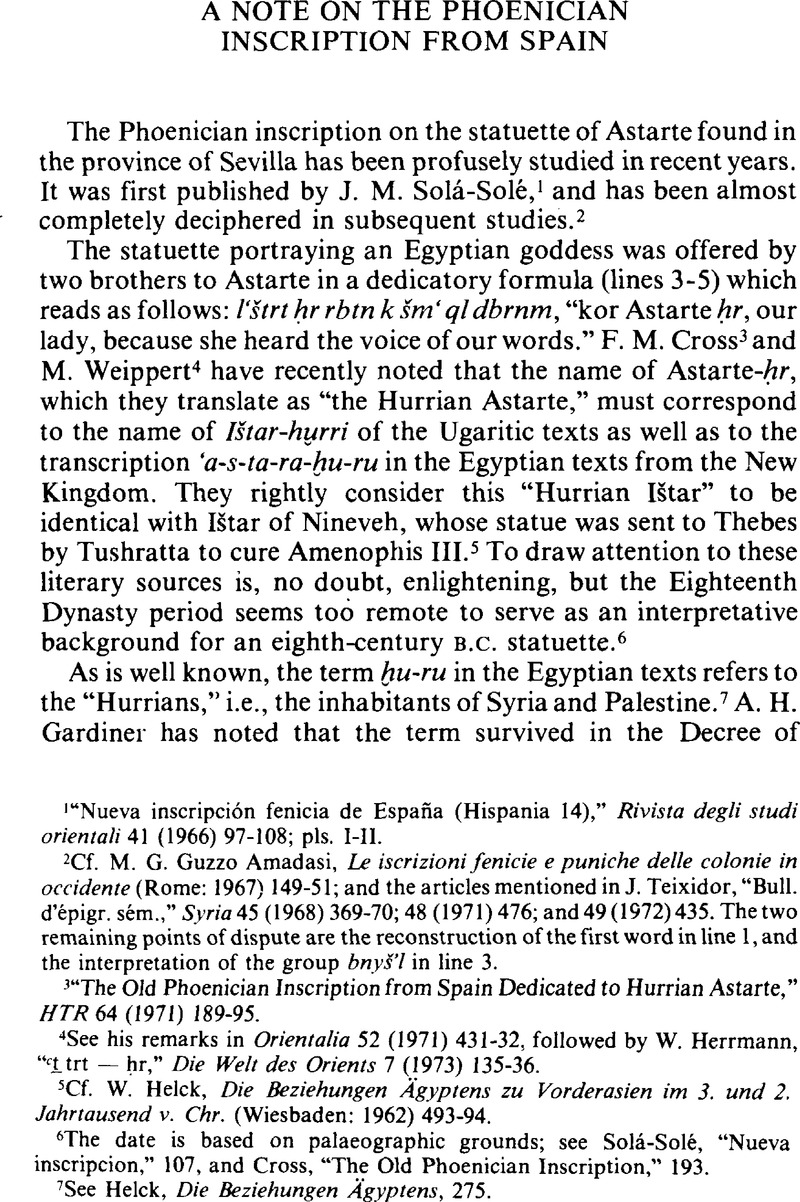No CrossRef data available.
Article contents
A Note on the Phoenician Inscription from Spain
Published online by Cambridge University Press: 10 June 2011
Abstract

- Type
- Notes and Observations
- Information
- Copyright
- Copyright © President and Fellows of Harvard College 1975
References
1 “Nueva inscripción fenicia de España (Hispania 14),” Rivista degli studi orientali 41 (1966) 97–108; pls. I–II.
2 Cf. M. G. Guzzo Amadasi, Le iscrizioni fenicie e puniche delle colonie in occidente (Rome: 1967) 149–51; and the articles mentioned in J. Teixidor, “Bull, d'épigr. sém.,” Syria 45 (1968) 369–70; 48 (1971) 476; and 49 (1972) 435. The two remaining points of dispute are the reconstruction of the first word in line 1, and the interpretation of the group bnyš'l in line 3.
3 “The Old Phoenician Inscription from Spain Dedicated to Hurrian Astarte,” HTR 64 (1971) 189–95.Google Scholar
4 See his remarks in Orientalia 52 (1971) 431–32,Google Scholar followed by Herrmann, W., “˓t trt — ḥr,” Die Welt des Orients 7 (1973) 135–36.Google Scholar
5 Cf. Helck, W., Die Beziehungen Ägyptens zu Vorderasien im 3. und 2. Jahrtausend v. Chr. (Wiesbaden: 1962) 493–94.Google Scholar
6 The date is based on palaeographic grounds; see Solá-Solé, “Nueva inscription,” 107, and Cross, “The Old Phoenician Inscription,” 193.
7 See Helck, Die Beziehungen Ägyptens, 275.
8 Ancient Egyptian Onomastica (London: Oxford University Press, 1947) 181*–82*.Google Scholar
9 Stadelmann, R., Syrisch-Palästinensische Gottheiten in Ägypten (Leiden: 1967) 107.Google Scholar
10 See Stadelmann, 104, and Leclant, J., art. “Astarte,” in W., Helck and E., Otto (eds.), Lexikon der Ägyptologie I 4 (Wiesbaden: 1973) cols. 499–509.Google Scholar
11 See Kiessling, E. (“Die Götter von Memphis in Griechisch-Römischer Zeit,” Archiv für Papyrusforschung 15 [1953] 21–22Google Scholar and 41) who correlates the text of Herodotus and the mention of the Phoinikaigyptioi of Memphis in a third-century B.C. Greek papyrus (Soc. ital. die Firenze, pap. gr. e lat. V, no. 531). It is noteworthy that Aimé-Giron, M. N. (Textes araméens d'Égypte [Cairo: 1931] 59–61Google Scholar) has drawn a parallel between the term “encampment” (stratopedori) used by Herodotus and that of degel which appears in fifth-century Aramaic Documents from Egypt; Porten, B. (Archives from Elephantine [Berkeley: University of California Press, 1968] 28–35)Google Scholar correctly interprets degel as being a “socio-military unit.”.




